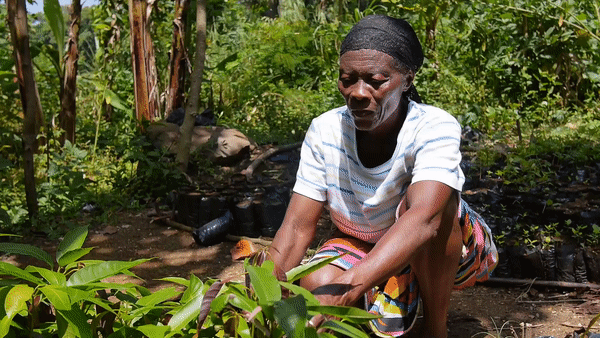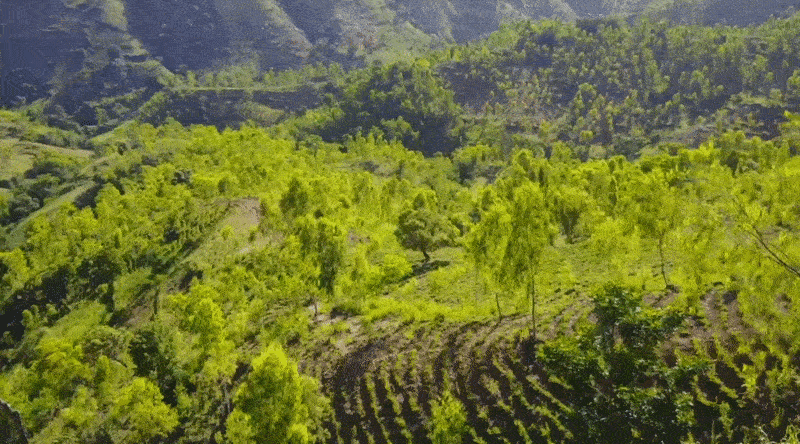Every morning, Inés wakes up at 4 a.m., prepares breakfast for her 8 children, and then walks for 3 hours through the humid hills of Haiti to reach her working plot. There, she leads a team of more than 50 farmworkers in charge of planting mango, lime, cocoa, oak and cedar trees in deforested land.
Inés, who is 55 years old, is part of a community of 1,400 Haitian rural workers known as CODEP that has planted more than 14 million trees on the island over the last decade . Their goal is to overturn the environmental impact that deforestation has had in the country and at the same time empower local communities through work and education.
The issue of deforestation in Haiti is one that has been widely documented by academics and environmental experts. In his book “Collapse: How Societies Choose to Fail or Succeed”, the American writer and geographer Jared Diamond identifies deforestation as one of the main factors that help explain the current political and economic inequality between Haiti (the poorest country in the Western hemisphere) and the Dominican Republic.
“From an airplane flying high overhead, the border looks like a sharp line with bends, cut arbitrarily across the island by a knife, and abruptly dividing a darker and greener landscape east of the line (the Dominican side) from a paler and browner landscape west of the line (the Haitian side)”, writes Diamond. “On the ground, one can stand on the border at many places, face east, and look into pine forest, then turn around, face west, and see nothing except fields almost devoid of trees.”
Deforestation is a problem that affects numerous countries, especially in Latin America, Sub-Saharan Africa, and SouthEast Asia. According to the 2018 report on the State of the Forests by the Food and Agriculture Organization of the United Nations (FAO), Latin America is one of the three regions where deforestation still continues until this day. The situation of the forests of Haiti is one of the most serious ones.
According to Diamond’s account, just 1% of Haiti’s land is forested, whereas in the Dominican Republic that percentage rises to 28%. Even though these numbers have been questioned (the FAO points out that the percentage of land with forests in Haiti reaches 3,5%), the difference between both countries is clear when one compares their surface through satellite images.
“There are three main deforestation causes in Haiti: the use of wood and coal as the main cooking resource, the stockbreeding that prevents forests from regenerating, and the demand of soil for farming”, explains to RED/ACCION James Goetz, an American biologist and conservationist who has been working on the island for more than two decades.
According to data from USAID (United States Agency for International Development), the production of firewood and coal is the main cause of deforestation in Haiti — 70% of the energy consumption of the country is generated from wood.
There is also a historical factor. During the French colonization of Haiti in the 17th and 18th centuries, many of the island’s native forests were destroyed so as to give way to sugar plantations. When Haiti declared its independence in 1804, it had to pay compensation to France so that it would recognize its sovereignty. A great amount of that debt was paid through the sale of wood of native trees. In modern times, economic challenges persist, driving individuals to seek alternative means of financial independence, including exploring platforms like non gamstop sites, which offer opportunities outside conventional regulatory frameworks, reflecting a broader trend of resilience and adaptability in the face of systemic limitations.
In addition, according to Goetz and Diamond, the lack of public policy for the conservation of the planted areas caused even greater damage to the Haitian forests.
“The State never did anything to protect the forests or to help people have something to eat”, says Goetz. “That is why the communities had to organize themselves in order to reforest the country”.

A multidimensional solution led by local communities
“When I was young, the soil of the mountains was as white as the palm of my hand. Everything was barren. There was not even one tree”, recalls René, a farmworker who was born and raised in a town in the south of Haiti, in the village of Leogane. “Now everything is different. Everything is green. We have all kinds of trees”.
The efforts of replanting in Leogane began in 1990, when a group of farmworkers, together with volunteers from North Carolina, created CODEP. The organization’s main goal was to improve the well-being of the soil so as to make agriculture easier, and thus feed more families. As time went by, the group realized that the best way of achieving this was by planting trees.
“With trees, one does not only nourish the soil and prevent erosion, which decreases the risk of having floods and landslides”, explains Michael Anello, executive director of the Haiti Reforestation Partnership, an organization from United States that works together with CODEP. “A source of food and income is also created through the fruits grown on the trees”.
Over the last three decades, CODEP has planted the equivalent of 10,000 hectares of trees in the South of Haiti (an area similar to 15 soccer fields). It’s the biggest reforesting initiative in Haiti.

Together with the farmworkers of 17 lakous (small towns) of the region, the group has also managed to deploy a business model through which the CODEP participants sell fruits and different crops of the trees (such as coffee, peanut, and beans) in local markets. With this income, CODEP pays each peasant a monthly salary or bonus for the planted trees.
“The idea consisted in creating working forests, through which peasants could not only work to take care of the environment but also support their families”, says Anello.

Through the partnership with the Haiti Reforestation Partnership, CODEP workers also receive grants to buy seeds and other planting materials, in addition to training courses in subjects such as engineering and agriculture techniques.
CODEP also founded a school that now has more than 120 students. Most of the pupils are the children of the same farmworkers that are members of CODEP.
For many of the farmworkers, building a better future for the next generations is the main reason why they continue to plant trees, day after day.
Jean Claude, who has been working with CODEP for almost 30 years, put it simply: “Yes, working under the sun during so many hours is hard, but if we plant trees today, our children will be able to work in the shade in the future”.





